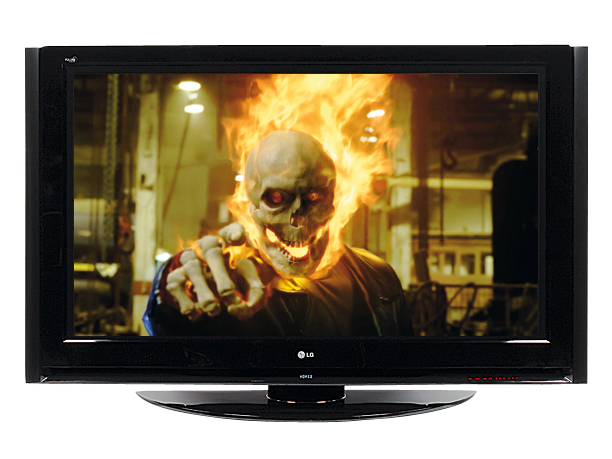TechRadar Verdict
Not the last word in plasma, but has a lot to admire and the price is low
Pros
- +
Great looking
Impressive specification
Works well with high-def material
Cons
- -
Average black levels
Weak standard-def pictures
Why you can trust TechRadar
The 60PF95's distinctive design comes from LG's Chocolate mobile phone, notable mostly for its snazzy keypad that glows when touched. The same style has been used to devastating effect on this 60in TV, which features a cluster of glowing touchpanel controls at the bottom of its gloss black frame.
However, there's more to this plasma TV than aesthetic gimmicks - this is also a 1080p-capable movie machine, with a 1920 x 1080 panel and support for 24 frames-per-second video, supplied by Blu-ray decks from Pioneer and Sony.
Such compatibility is vital given that the 60PF95 is likely to be used as the centrepiece of a serious home cinema system, and images need to be as film-like as possible. But for other types of material, the set will also handle 30Hz, 50Hz and 60Hz speeds.
The 60PF95 is supplied with an attractive stand, but at 64kg, you'll need a strong AV cabinet to hold it. And you might want to consult a structural engineer - or a home cinema installer - before wall mounting it.
Around the back is a solid line-up of sockets, including two HDMIs and two Scarts, plus component and PC inputs. An optical digital audio output can pipe sound to an amp, while the side-mounted AV inputs make it easy to hook up peripherals.
The set also boasts a satisfying range of features, including a digital tuner (with a CI slot for pay TV) and LG's XD Engine Full HD image processor. The set's contrast ratio of 3,000:1 and 1,000cd/m2 brightness sound promising, while two 10W speakers (helped by Surround MAX) provide the set's audio.
Imperfect black
A TV of this size is made for hi-def, and the 60PF95 delivers its best pictures when fed material from a Blu-ray or HD DVD player, or a Sky HD or Virgin Media set-top box.
Pictures look wonderfully crisp and detailed, plus the powerful colour tones radiating from the screen lend the picture priceless warmth and dynamism.
The spectacular colours on display aren't matched by the 60PF95's black levels, which are good rather than great. Blacks are a tad faded, lacking the realistic, ultra-deep tones seen in sets like Pioneer's G8 series. That said, even an underwhelming blacks like these beats those of the best LCD TVs.
With pseudo hi-def from an upscaling DVD player, the LG continues to impress, reproducing the flaming reds and oranges of Ghost Rider's palette with aplomb. But switch to the standard-def and things go a bit wrong, as the huge screen magnifies the flaws in analogue signals and reduces the picture clarity.
The integrated digital tuner fares better, but once again the bigscreen draws undue attention to the signal's inherent noise.
When it comes to sound, the LG bucks the flatpanel trend of weedy, insignificant audio reproduction to offer a rousing rendition of movie soundtracks. The pseudo-surround mode works a treat, sending forth a wave of sound that envelops the listener, underpinned by a decent amount of booming bass.
Worthy purchase
Viewed purely from a performance perspective, the 60PF95 has its shortcomings, such as average black level and noisy standard-def pictures. But bearing in mind that a 60in plasma would set you back around £15,000 a few years ago, its £3,500 price tag is nothing short of incredible, and for that money it might be worth putting up with a few foibles.
Tech.co.uk was the former name of TechRadar.com. Its staff were at the forefront of the digital publishing revolution, and spearheaded the move to bring consumer technology journalism to its natural home – online. Many of the current TechRadar staff started life a Tech.co.uk staff writer, covering everything from the emerging smartphone market to the evolving market of personal computers. Think of it as the building blocks of the TechRadar you love today.
